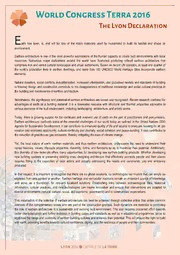
The Lyon Declaration PDF
Preview The Lyon Declaration
E arth has been, is, and will be one of the major materials used by humankind to build its habitat and shape its environment. Earthen architecture is one of the most powerful expressions of the human capacity to create built environments with local resources. Numerous major civilizations around the world have flourished producing refined earthen architecture that comprises rich and varied cultural landscapes and urban settlements. Based on recent UN statistics, at least one quarter of the world’s population lives in earthen dwellings, and more than 180 UNESCO World Heritage Sites incorporate earthen elements. Natural disasters, social conflicts, industrialisation, increased urbanisation, and globalised models and standards of building in housing design and construction contribute to the disappearance of traditional knowledge and social-cultural practices in the building and maintenance of earthen architecture. Nonetheless, the significance and potential of earthen architecture are known and recognised. Recent research confirms the advantages of earth as a building material. It is a renewable resource with structural and thermal properties applicable to various elements of the built environment, including landscaping, architecture, and artistic works. Today, there is growing support for the continued and renewed use of earth on the part of practitioners and policymakers. Earthen architecture confronts some of the essential challenges of our world today as outlined in the United Nations 2030 Agenda for Sustainable Development. It can contribute to enhanced quality of life and access to adequate housing for all, job creation and economic opportunity, cultural continuity and diversity, social cohesion and peace-building. It also contributes to the reduction of greenhouse gas emissions, thereby mitigating the risks of climate change. Yet, the local nature of earth, earthen materials, and thus earthen architecture, underscores the need to understand their varied histories, values, life-cycle properties, durability, forms, and functions so as to maximise their potential. Additionally, this diversity of raw materials offers many opportunities for developing new earthen building products. Whether developing new building systems or preserving existing ones, designing architecture that effectively connects people and their places requires fitting to the capacities of local actors and actually addressing the needs and constraints, use and ambiance produced. In that respect, it is important to recognise that there are no global solutions, no technologies nor models that can simply be exported from one context to another. Earthen heritage and vernacular traditions remain an important source of knowledge and serve as a foundation for relevant localised solutions. Establishing links between archaeological data, historical information, cultural practices, and new technologies can inspire innovation and ensure that interventions are adapted to diverse environments (natural, cultural, social, and economic, governance) and to communities’ expectations. This valorisation of the potential of earthen architecture can best be achieved through collective action that unites common interests of the complementary actors who are part of the construction process. Such dynamics are essential to promoting the role of earthen architecture in a sustainable and evolving built environment. This also requires concerted effort towards better characterisation and further inclusion in building codes and standards as well as in educational programmes, so as to legitimise the range and continuity of earthen building cultures and enhance their potential. This will ensure the right to build with earth, providing benefits towards cultural confidence, dignity, and the resilience of people and their communities..
